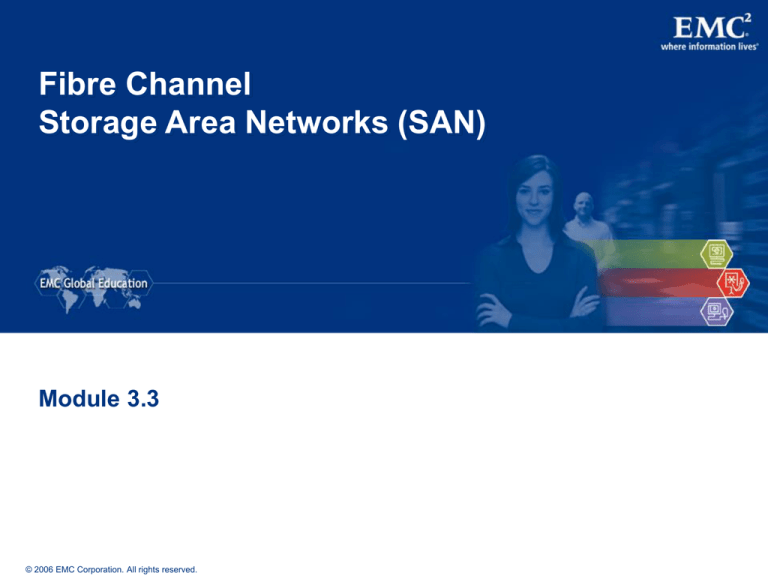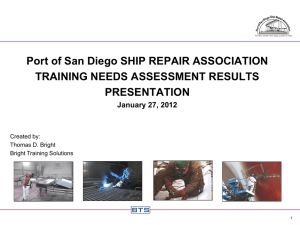
Fibre Channel
Storage Area Networks (SAN)
Module 3.3
© 2006 EMC Corporation. All rights reserved.
Fibre Channel Storage Area Networks (SAN)
Upon completion of this module, you will be able to:
Describe the features and benefits of SAN.
Describe the physical and logical elements of SAN.
List common SAN topologies.
Compare and contrast connectivity devices.
Describe connectivity options of SAN.
Describe the I/O flow in the SAN environment.
List SAN management considerations.
Describe applications of a SAN strategy.
© 2006 EMC Corporation. All rights reserved.
Storage Area Networks (SAN) - 2
In this module …
This module contains the following lessons:
Fibre Channel SAN Overview.
The Components of a SAN.
FC SAN Connectivity.
SAN Management.
SAN Deployment Examples.
Case Study and Applications of FC SAN.
© 2006 EMC Corporation. All rights reserved.
Storage Area Networks (SAN) - 3
Lesson: Fibre Channel SAN Overview
Upon completion of this lesson, you will be able to:
Define a FC SAN.
Describe the features of FC SAN based storage.
Describe the benefits of an FC SAN based storage
strategy.
© 2006 EMC Corporation. All rights reserved.
Storage Area Networks (SAN) - 4
Business Needs and Technology Challenges
Information when and where the business user needs it
Integrate technology infrastructure with business
processes
Flexible, resilient architecture
© 2006 EMC Corporation. All rights reserved.
Storage Area Networks (SAN) - 5
What is a SAN?
Array
Dedicated storage network
Organized connections
among:
Switches
Storage
Communication devices
Server
Systems
Secure
Robust
© 2006 EMC Corporation. All rights reserved.
Servers
Storage
Storage Area Networks (SAN) - 6
Evolution of Fibre Channel SAN
Servers
HUB
Switches
Switches
Storage
Servers
SAN Islands
FC
Arbitrated Loop
© 2006 EMC Corporation. All rights reserved.
Storage
Servers
Interconnected
SANs
FC
Switched Fabric
Arrays
Storage
Enterprise SANs
FC Switched Fabric
Storage Area Networks (SAN) - 7
Benefits of a SAN
High bandwidth
– Fibre Channel
SCSI extension
– Block I/O
Resource Consolidation
– Centralized storage and management
Scalability
– Up to 16 million devices
Secure Access
– Isolation and filtering
© 2006 EMC Corporation. All rights reserved.
Storage Area Networks (SAN) - 8
Lesson Summary
Topics in this lesson included:
Definition of a SAN
Features and Benefits of SANs
© 2006 EMC Corporation. All rights reserved.
Storage Area Networks (SAN) - 9
Lesson: The Components of a SAN
Upon completion of this lesson, you will be able to:
Describe the elements of a SAN.
– Host Bus Adapter (HBA)
– Fiber Cabling
– Fibre Channel Switch /Hub
– Storage Array
– Management System
© 2006 EMC Corporation. All rights reserved.
Storage Area Networks (SAN) - 10
Components of a Storage Area Network
Host Bus Adapter (HBA)
Fiber Cabling
Fibre Channel Switch /Hub
Storage Array
Management System
HBA
Switches
SAN-attached Server
SAN
Arrays
© 2006 EMC Corporation. All rights reserved.
Storage Area Networks (SAN) - 11
Nodes, Ports, & Links
HBA
Port 0
Tx
Rx
Link
Port 0
Port
Port 11
Port
Port n
n
Node
© 2006 EMC Corporation. All rights reserved.
Storage Area Networks (SAN) - 12
Host Bus Adapters
HBAs perform low-level interface functions automatically
to minimize the impact on host processor performance
HBA
Switches
Arrays
Server
© 2006 EMC Corporation. All rights reserved.
Storage Area Networks (SAN) - 13
Connectivity
Single Mode
Fiber
Switches
Multimode
Fiber
Host
Storage
© 2006 EMC Corporation. All rights reserved.
Storage Area Networks (SAN) - 14
Connectors
Node Connectors:
SC Duplex Connectors
LC Duplex Connectors
Patch panel Connectors
ST Simplex Connectors
© 2006 EMC Corporation. All rights reserved.
Storage Area Networks (SAN) - 15
Connectivity Devices
Basis for SAN communication
– Hubs, Switches and Directors
Server
© 2006 EMC Corporation. All rights reserved.
HBA
Switches
Arrays
Storage Area Networks (SAN) - 16
Storage Resources
Storage Array
– Provides storage consolidation and
centralization
Features of an array
– High Availability/Redundancy
– Performance
– Business Continuity
– Multiple host connect
© 2006 EMC Corporation. All rights reserved.
Server
HBA
Switches
Arrays
Storage Area Networks (SAN) - 17
SAN Management Software
A suite of tools used in a SAN
to manage the interface
between host and storage
arrays.
Provides integrated
management of SAN
environment.
Web based GUI or CLI
© 2006 EMC Corporation. All rights reserved.
Storage Area Networks (SAN) - 18
Lesson: Summary
Topics in this lesson included:
The elements of a SAN:
– Host Bus Adapter (HBA)
– Fiber Cabling
– Fibre Channel Switch /Hub
– Storage Array
– Management System
© 2006 EMC Corporation. All rights reserved.
Storage Area Networks (SAN) - 19
Lesson: Fibre Channel SAN Connectivity
Upon completion of this lesson, you will be able to:
Describe the Fibre Channel SAN connectivity methods
and topologies
Describe Fibre Channel devices
Describe Fibre Channel communication protocols
Describe Fibre Channel login procedures
© 2006 EMC Corporation. All rights reserved.
Storage Area Networks (SAN) - 20
Fibre Channel SAN Connectivity
Core networking principles
applied to storage
Servers are attached to 2
distinct networks
– Back-end
– Front-end
SAN
switches
directors
IP
network
Users &
Application
Clients
Servers &
Applications
Storage &
Application
Data
© 2006 EMC Corporation. All rights reserved.
Storage Area Networks (SAN) - 21
What is Fibre Channel?
SAN Transport Protocol
– Integrated set of standards (ANSI)
– Encapsulates SCSI
A High Speed Serial Interface
– Allows SCSI commands to be transferred over a storage network.
Standard allows for multiple protocols over a single
interface.
© 2006 EMC Corporation. All rights reserved.
Storage Area Networks (SAN) - 22
Fibre Channel Ports
Servers
NL Port
NL Port
NL Port
Node
Server
Node
Storage
HUB
HUB
NL Port
Node
NL Port
FL Port
FL Port
Server
E Port
N Port
Node
F Port
F Port
Node
N Port
Switch
F Port
E Port
Switch
Switch
N Port
Node
F Port
N Port
Node
Array
Array
Storage
© 2006 EMC Corporation. All rights reserved.
Storage Area Networks (SAN) - 23
World Wide Names
Unique 64 bit identifier.
Static to the port.
– Used to physically identify a port or node within the SAN
– Similar to a NIC MAC address
Additionally, each node is assigned a unique port ID
(address) within the SAN
– Used to communicate between nodes within the SAN
– Similar in functionality to an IP address on a NIC
© 2006 EMC Corporation. All rights reserved.
Storage Area Networks (SAN) - 24
World Wide Names: Example
World Wide Name – Array
5
0
0
6
0
1
6
0
0
0
6
0
0
1
B
2
0101
0000
0000
0110
0000
0001
0110
0000
0000
0000
0110
0000
0000
0001
1011
0010
c
4
0
Company ID
24 bits
Port
Model seed
32 bits
World Wide Name - HBA
1
0
0
0
Reserved
12 bits
© 2006 EMC Corporation. All rights reserved.
0
0
0
0
Company OUI
24 bits
c
9
2
0
d
Company Specific
24 bits
Storage Area Networks (SAN) - 25
Fibre Channel Logins
Fabric
N Port 1
F Port
F Port
N Port 2
Process a
Process x
Process b
Process y
Process c
Process z
© 2006 EMC Corporation. All rights reserved.
Storage Area Networks (SAN) - 26
Fibre Channel Addressing
Fibre Channel addresses are used for transporting
frames from source ports to destination ports.
Address assignment methods vary with the associated
topology (loop vs switch)
– Loop – self assigning
– Switch – centralized authority
Certain addresses are reserved
– FFFFFC is Name Server
– FFFFFE is Fabric Login
© 2006 EMC Corporation. All rights reserved.
Storage Area Networks (SAN) - 27
What is a Fabric?
Virtual space used by nodes to
communicate with each other
once they are joined.
Component identifiers:
– Domain ID
Arrays
Servers
Fabric
– Worldwide Name (WWN)
Switches
Storage
© 2006 EMC Corporation. All rights reserved.
Storage Area Networks (SAN) - 28
Fibre Channel Topologies
Arbitrated Loop (FC-AL)
– Devices attached to a shared
“loop”
HUB
– Analogous to Token Ring
Clients
Storage
Switched Fabric (FC-SW)
Arrays
– All devices connected to a “Fabric
Switch” – Analogous to an IP
switch
– Initiators have unique dedicated
I/O paths to Targets
© 2006 EMC Corporation. All rights reserved.
Clients
Switch
Storage Area Networks (SAN) - 29
Switch versus Hub Comparison
Switches (FC-SW)
– FC-SW architecture scalable to
millions of connections.
– Bandwidth per device stays
constant with increased
connectivity.
– Bandwidth is scalable due to
dedicated connections.
– Higher availability than hubs.
– Higher cost.
© 2006 EMC Corporation. All rights reserved.
Hubs (FC-AL)
– FC-AL is limited to 127
connections (substantially fewer
connections can be implemented
for ideal system performance).
– Bandwidth per device diminishes
with increased connectivity due to
sharing of connections.
– Low cost connection.
Storage Area Networks (SAN) - 30
How an Arbitrated Loop Hub Works
Node A
NL_Port
NL_Port
#1
#1
Node D
Transmit
Hub_Pt
Hub_Pt
Byp
Byp
HBA
HBA
Byp
Byp
Receive
Receive
HBA
Transmit
Node B
NL_Port
NL_Port
#4
#4
HBA
HBA
© 2006 EMC Corporation. All rights reserved.
NL_Port
NL_Port
#2
#2
Node C
Transmit
Receive
Receive
Byp
Byp
Byp
Byp
Hub_Pt
Hub_Pt
NL_Port
NL_Port
#3
#3
FA
Transmit
Storage Area Networks (SAN) - 31
How a Switched Fabric Works
Node A
NL_Port
N_Port
#1
Node D
Transmit
Port
Port
Receive
#1
#2
Storage
HBA
Port
HBA
HBA
Receive
Transmit
Node B
NL_Port
N_Port
#4
#4
Node C
Transmit
Receive
N_Port
#3
NL_Port
#3
HBA
HBA
Receive
© 2006 EMC Corporation. All rights reserved.
N_Port
#2
NL_Port
Port
Port
Transmit
Storage
FA
Port
Storage Area Networks (SAN) - 32
Inter Switch Links (ISLs)
Multimode Fiber
1Gb=500m 2Gb=300m
Switch
Switch
Single-mode Fiber
up to10 km
Switch
Switch
Metro ring or point-to-point
topologies with or without
path protection
Switch
© 2006 EMC Corporation. All rights reserved.
Router
Router
Switch
Storage Area Networks (SAN) - 33
Topology: Mesh Fabric
Can be either partial or full mesh
All switches are connected to each other
Host and Storage can be located anywhere in the fabric
Host and Storage can be localized to a single switch
Partial Mesh
© 2006 EMC Corporation. All rights reserved.
Full Mesh
Storage Area Networks (SAN) - 34
Full Mesh Benefits
Benefits
– All storage/servers are a maximum of one ISL hop away.
– Hosts and storage may be located anywhere in the fabric.
– Multiple paths for data using the Fabric Shortest Path First (FSPF)
algorithm.
– Fabric management made simpler.
© 2006 EMC Corporation. All rights reserved.
Storage Area Networks (SAN) - 35
Topology: Simple Core-Edge Fabric
Can be two or three tiers
– Single Core Tier
– One or two Edge Tiers
Host Tier
In a two tier topology,
storage is usually
connected to the Core
Benefits
– High Availability
– Medium Scalability
– Medium to maximum
Connectivity
© 2006 EMC Corporation. All rights reserved.
Storage Tier
Storage Area Networks (SAN) - 36
Core-Edge Benefits
Simplifies propagation of fabric data.
– One ISL hop access to all storage in the fabric.
Efficient design based on node type.
– Traffic management and predictability.
Easier calculation of ISL loading and traffic patterns.
© 2006 EMC Corporation. All rights reserved.
Storage Area Networks (SAN) - 37
Lesson: Summary
Topics in this lesson included:
The Fibre Channel SAN connectivity methods and
topologies
Fibre Channel devices
Fibre Channel communication protocols
Fibre Channel login procedures
© 2006 EMC Corporation. All rights reserved.
Storage Area Networks (SAN) - 38
Lesson: SAN Management
Upon completion of this lesson, you will be able to:
Describe SAN management functions
– Infrastructure protection
– Provisioning
– Capacity Management
– Performance Management
© 2006 EMC Corporation. All rights reserved.
Storage Area Networks (SAN) - 39
SAN Management Overview
Infrastructure protection
Fabric Management
Storage Allocation
Capacity Tracking
Performance Management
© 2006 EMC Corporation. All rights reserved.
Storage Area Networks (SAN) - 40
Infrastructure Security
Physical security
Corporate LAN
Secure
VPN
or
Firewall
– Locked data center
Servers
Centralized server and storage
infrastructure
– Controlled administrator access
Control
Station
Switch
Management
LAN (Private)
Switch
In-band (FC)
Storage Arrays
© 2006 EMC Corporation. All rights reserved.
Out-band (IP)
Storage Area Networks (SAN) - 41
Switch/Fabric Management Tools
Vendor supplied management software
– Embedded within the switch
– Graphical User Interface (GUI) or Command Line Interface (CLI)
Functionality
– Common functions
Performance monitoring
Discovery
Access Management (Zoning)
– Different “look and feel” between vendors
Additional third party software add-ons
– Enhanced functionality, such as automation
© 2006 EMC Corporation. All rights reserved.
Storage Area Networks (SAN) - 42
Fabric Management: Zoning
Servers
Arrays
© 2006 EMC Corporation. All rights reserved.
Storage Area Networks (SAN) - 43
Zoning Components
Zones Sets
(Library)
Zone Set
Zones
(Library)
Members
(WWN’s)
Zone
Member
© 2006 EMC Corporation. All rights reserved.
Member
Zone
Member
Member
Zone
Member
Member
Storage Area Networks (SAN) - 44
Types of Zoning
Servers
WWN
10:00:00:00:C9:20:DE:56
WWN
10:00:00:00:C9:20:DC:40
Domain ID = 21
Port = 1
Array
Switches
Domain ID = 25
Port = 3
WWN
50:06:04:82:E8:91:2B:9E
Examples:
WWN Zone 1 = 10:00:00:00:C9:20:DC:40; 50:06:04:82:E8:91:2B:9E
Port Zone 1 = 21,1; 25,3
Mixed Zone 1 = 10:00:00:00:C9:20:DE:56; Port 21/1
© 2006 EMC Corporation. All rights reserved.
Storage Area Networks (SAN) - 45
Single HBA Zoning
Optimally, one HBA per zone.
– Nodes can only “talk” to Storage in the same zone
Storage Ports may be members of more than one zone.
HBA ports are isolated from each other to avoid potential
problems associated with the SCSI discovery process.
– Also known as “chatter”
Decreases the impact of a changes in a Fabric by
reducing the amount of nodes that must communicate.
© 2006 EMC Corporation. All rights reserved.
Storage Area Networks (SAN) - 46
Provisioning: LUN Masking
Restricts volume access to
specific hosts and/or
host clusters.
Servers can only access the
volumes that they are assigned.
Access controlled in the storage
and not in the fabric
– Makes distributed administration
secure
Tools to manage masking
Switch
– GUI
– Command Line
Servers
© 2006 EMC Corporation. All rights reserved.
Array
Storage Area Networks (SAN) - 47
Capacity Management
Tracking and managing assets
– Number of ports assigned
– Storage allocated
Utilization profile
– Indicates resource utilization over time
– Allows for forecasting
SAN management software provides the tools
– Inventory databases
– Report writers
© 2006 EMC Corporation. All rights reserved.
Storage Area Networks (SAN) - 48
Performance Management
What is it?
– Capturing metrics and monitoring trends
– Proactively or Reactively responding
– Planning for future growth
Areas and functions
– Host, Fabric and Storage Performance
– Building baselines for the environment
© 2006 EMC Corporation. All rights reserved.
Storage Area Networks (SAN) - 49
Lesson: Summary
Topics in this lesson included:
– Infrastructure protection
– Provisioning
– Capacity Management
– Performance Management
© 2006 EMC Corporation. All rights reserved.
Storage Area Networks (SAN) - 50
Lesson: SAN Deployment Examples
Upon completion of this lesson, you will be able to:
Describe common SAN deployment considerations
Explain SAN deployment examples
Describe SAN Challenges
© 2006 EMC Corporation. All rights reserved.
Storage Area Networks (SAN) - 51
When Should a SAN be Used?
SANs are optimized for high bandwidth block level I/O
Suited for the demands of real time applications
– Databases: OLTP (online transaction processing)
– Video streaming
Any applications with high transaction rate and high data
volatility
– Stringent requirements on I/O latency and throughput
Used to consolidate heterogeneous storage
environments
– Physical consolidation
– Logical consolidation
© 2006 EMC Corporation. All rights reserved.
Storage Area Networks (SAN) - 52
Consolidation Example: DAS Challenge
Servers
Servers
Servers
Storage
© 2006 EMC Corporation. All rights reserved.
Storage Area Networks (SAN) - 53
Consolidation Example: SAN Solution
Servers
Servers
Servers
Array
Switch
© 2006 EMC Corporation. All rights reserved.
Storage Area Networks (SAN) - 54
Connectivity Example: Challenge
Server
Array
Server
Switches
Array
Server
Server
© 2006 EMC Corporation. All rights reserved.
Server
Storage Area Networks (SAN) - 55
Connectivity Example: Solution
Server
Server
Switches
Server
Server
Server
Array
© 2006 EMC Corporation. All rights reserved.
Storage Area Networks (SAN) - 56
FC SAN Challenges
Infrastructure
– New, separate networks are required.
Skill-sets
– As a relatively new technology, FC SAN administrative skills need to
be cultivated.
Cost
– Large investments are required for effective implementation.
© 2006 EMC Corporation. All rights reserved.
Storage Area Networks (SAN) - 57
Lesson: Summary
Topics in this lesson included:
Common SAN deployment considerations.
SAN Implementation Scenarios
– Consolidation
– Connectivity
SAN Challenges
© 2006 EMC Corporation. All rights reserved.
Storage Area Networks (SAN) - 58
Module Summary
Topics in this module included:
The features and benefits of SAN.
The physical and logical elements of SAN.
The common SAN topologies.
Comparison of SAN connectivity devices.
The connectivity options of SAN.
The I/O flow in the SAN environment.
SAN management considerations.
Applications of a SAN strategy.
© 2006 EMC Corporation. All rights reserved.
Storage Area Networks (SAN) - 59
Check Your Knowledge
Name three key features of a SAN implementation.
What is a Switch?
Describe how a SAN can be connected?
What is one common SAN topology?
What are two management considerations for a SAN
environment?
What is a Fabric?
What is a Core-Edge Fabric?
© 2006 EMC Corporation. All rights reserved.
Storage Area Networks (SAN) - 60
Apply Your Knowledge
Connectrix™ Family of
SAN Switches and Directors
© 2006 EMC Corporation. All rights reserved.
Storage Area Networks (SAN) - 61
Apply Your Knowledge…
Upon completion of this topic, you will be able to:
Describe EMC’s product implementation of the
Connectrix™ Family of SAN Switches and Directors.
© 2006 EMC Corporation. All rights reserved.
Storage Area Networks (SAN) - 62
The Connectrix Family
High-speed Fibre Channel connectivity1 to 10 gigabits per second
Highly resilient switching technology, and
ED-10000M
options for IP storage networking.
configure to adapt to any business need
MDS-9509
ED-48000B
MDS-9506
AP-7420B
ED-140M
MP-2640M
MP-1620M
MDS-9216i/A
MDS-9140
DS-4100B
MDS-9120
DS-4700M
DS-220B
DS-4400M
© 2006 EMC Corporation. All rights reserved.
Storage Area Networks (SAN) - 63
Switches versus Directors
Connectrix Switches
– High availability through
redundant deployment
– Redundant fans and power
supplies
– Departmental deployment
or part of Data Center
deployment
– Small to medium fabrics
– Multi-protocol possibilities
© 2006 EMC Corporation. All rights reserved.
Connectrix Directors
– “Redundant
everything”
provides optimal
serviceability and highest
availability
– Data center deployment
– Maximum scalability
– Maximum performance
– Large fabrics
– Multi-protocol
Storage Area Networks (SAN) - 64
Connectrix Switch - DS-220B
Provides eight, 12, or 16 ports
– Auto-detecting 1, 2, and 4 Gb/s Fibre Channel ports
– Single, fixed power supply
– Field-replaceable optics
– Redundant cooling
Simplified setup—no previous SAN experience needed
– Eliminates the need for advanced skills to manage IP addressing or
Zoning
© 2006 EMC Corporation. All rights reserved.
Storage Area Networks (SAN) - 65
Connectrix Director – MDS 9509
Multi-transport switch—Fibre
Channel, FICON, iSCSI, FCIP
– 16 to 224 Fibre Channel ports
– 4–56 Gigabit Ethernet ports for iSCSI
or FCIP
– Non-blocking fabric
– 1 / 2 Gb/s auto-sensing ports
All components are fully
redundant
MDS-9509
© 2006 EMC Corporation. All rights reserved.
Storage Area Networks (SAN) - 66
Connectrix Management Interfaces
MDS-Series
Fabric Manager
M-Series
Web Server
B-Series
Web Tools
© 2006 EMC Corporation. All rights reserved.
Storage Area Networks (SAN) - 67
Module Summary
The Connectrix Family of Switches and Directors;
Has three product sets:
– Connectrix B-Series
– Connectrix MDS 9000 Series
– Connectrix M-Series
Provides highly available access to storage.
Connects a wide range of host and storage technologies.
© 2006 EMC Corporation. All rights reserved.
Storage Area Networks (SAN) - 68







